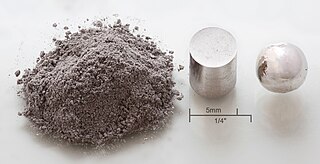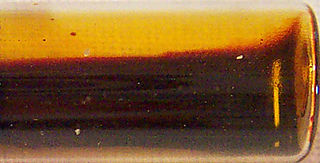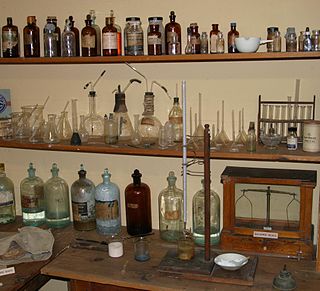
Palladium is a chemical element; it has symbol Pd and atomic number 46. It is a rare and lustrous silvery-white metal discovered in 1803 by the English chemist William Hyde Wollaston. He named it after the asteroid Pallas, which was itself named after the epithet of the Greek goddess Athena, acquired by her when she slew Pallas. Palladium, platinum, rhodium, ruthenium, iridium and osmium form a group of elements referred to as the platinum group metals (PGMs). They have similar chemical properties, but palladium has the lowest melting point and is the least dense of them.

Rhodium is a chemical element; it has symbol Rh and atomic number 45. It is a very rare, silvery-white, hard, corrosion-resistant transition metal. It is a noble metal and a member of the platinum group. It has only one naturally occurring isotope, which is 103Rh. Naturally occurring rhodium is usually found as a free metal or as an alloy with similar metals and rarely as a chemical compound in minerals such as bowieite and rhodplumsite. It is one of the rarest and most valuable precious metals.

BASF SE, an initialism and portmanteau of its original name Badische Anilin- und Sodafabrik, is a European multinational company and the largest chemical producer in the world. Its headquarters are located in Ludwigshafen, Germany.

A catalytic converter is an exhaust emission control device which converts toxic gases and pollutants in exhaust gas from an internal combustion engine into less-toxic pollutants by catalyzing a redox reaction. Catalytic converters are usually used with internal combustion engines fueled by gasoline or diesel, including lean-burn engines, and sometimes on kerosene heaters and stoves.
Heraeus is a German technology group with a focus on precious and special metals, medical technology, quartz glass, sensors and specialty light sources as well as electronic components. Founded in Hanau in 1851, the company is one of the largest family-owned companies in Germany in terms of revenue. Heraeus employs 17,200 people in 40 countries and generated a total revenue of €29.1 billion in 2022. The headquarters and head office are in Hanau, Germany.

The Perth Mint is Australia's official bullion mint and wholly owned by the Government of Western Australia. Established on 20 June 1899, two years before Australia's Federation in 1901, the Perth Mint was the last of three Australian colonial branches of the United Kingdom's Royal Mint intended to refine gold from the gold rushes and to mint gold sovereigns and half-sovereigns for the British Empire. Along with the Royal Australian Mint, which produces coins of the Australian dollar for circulation, the Perth Mint is the older of Australia's two mints issuing coins that are legal tender.

Albemarle Corporation is an American specialty chemicals manufacturing company based in Charlotte, North Carolina. It operates 3 divisions: lithium, bromine specialties and catalysts.
Charles W. Engelhard Jr. was an American businessman, a major owner in Thoroughbred horse racing, and a candidate in the 1955 New Jersey State Senate elections. He controlled an international mining and metals conglomerate, Engelhard, founded by his father.
Envela Corporation, incorporated on September 17, 1965, is a holding company owning subsidiaries engaged in various business activities with a focus on recommerce. Envela's segments include retail stores, e-commerce, de-manufacturing, recycling, IT asset disposition (ITAD), and reverse logistics. Envela Corporation is divided into two sectors: DGSE, LLC and ECHG.

Phibro is an international physical commodities trading firm. Phibro trades in crude oil, oil products, natural gas, precious and base metals, agricultural products, commodity-related equities, and other products. Phibro’s headquarters are located in Stamford, Connecticut.
Carl Donald Keith was a chemist who was inventor of the three-way catalytic converter, which has played a dramatic role in reducing pollution from motor vehicles since their introduction in the mid-1970s.
John Joseph Mooney was an American chemical engineer who was co-inventor of the three-way catalytic converter, which has played a dramatic role in reducing pollution from motor vehicles since their introduction in the mid-1970s.

Umicore N.V., known as Union Minière before 2001,. is a multinational materials technology company headquartered in Brussels, Belgium.

A metallurgical assay is a compositional analysis of an ore, metal, or alloy, usually performed in order to test for purity or quality.

MMTC Ltd. is one of the two highest earners of foreign exchange for India and India's largest public sector trading body. Not only handling the export and import of primary products such as coal, iron ore, agro and industrial products, MMTC also exports and imports important commodities such as ferrous and nonferrous metals for industry, and agricultural fertilizers. MMTC's diverse trade activities cover third country trade, joint ventures and link deals and all modern forms of international trading. The company has a vast international trade network, spanning almost in all countries in Asia, Europe, Africa, Oceania, and in the United States and also includes a wholly owned international subsidiary in Singapore, MTPL. It is one of the Miniratnas companies.

ScotiaMocatta, originally founded as Mocatta Bullion in 1684, was a precious metal and base metal trading company that operated as the metals trading division of the Bank of Nova Scotia (Scotiabank) from 1997 until January 2019.

The Bottom-blown Oxygen Converter or BBOC is a smelting furnace developed by the staff at Britannia Refined Metals Limited (“BRM”), a British subsidiary of MIM Holdings Limited. The furnace is currently marketed by Glencore Technology. It is a sealed, flat-bottomed furnace mounted on a tilting frame that is used in the recovery of precious metals. A key feature is the use of a shrouded lance to inject oxygen through the bottom of the furnace, directly into the precious metals contained in the furnace, to oxidize base metals or other impurities as part of their removal as slag.
PAMP SA is an independently operated precious metals refining and fabricating company and member of the MKS Group. It was established in 1977 in Ticino, Switzerland.

Tadeusz (Thadée) Nowicki is an industrialist who is the founder and president of the ERGIS Group.
Ludwig Jesselson was a German-born metal trader who served as president and CEO of Philipp Brothers.













